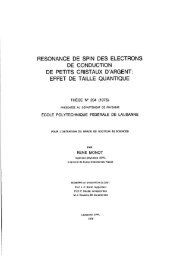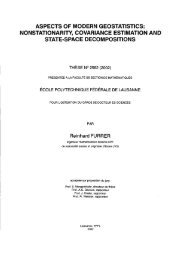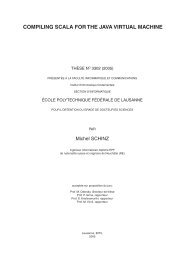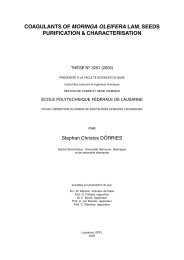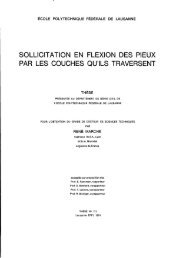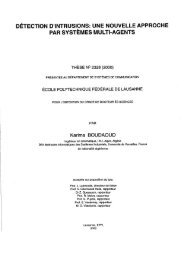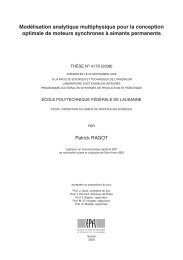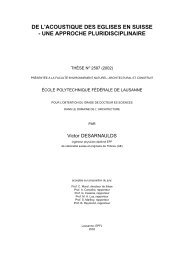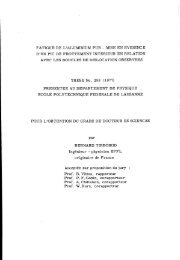PHYSICO-CHEMICAL ASPECTS OF THE ADHESION AND ... - EPFL
PHYSICO-CHEMICAL ASPECTS OF THE ADHESION AND ... - EPFL
PHYSICO-CHEMICAL ASPECTS OF THE ADHESION AND ... - EPFL
You also want an ePaper? Increase the reach of your titles
YUMPU automatically turns print PDFs into web optimized ePapers that Google loves.
SUMMARY<br />
Nosocornial (hospital acquired) pneumonia is a major medical complication in intubated<br />
and mechanically ventilated patients. The bacterium Pseudomonns aerugir~osa is one of the<br />
most prevalent nosocomial pathogen, responsible for 30 % of nosocomial infections, of which<br />
47 % are ventilator-associated pneumonia (VAP). Prolonged intubation with an endotracheal<br />
device is a major risk factor for VAP, where colonization of the upper respiratory tract by<br />
P. neruginosa occurs in 90 % of patients, with a mortality reaching 40 % despite aggressive<br />
antibiotic therapy. Therefore, a new strategy to prevent or at least to delay the occurrence of<br />
VAP due to P. neruginosa is desirable. Successful bacterial colonization of the upper<br />
respiratory tract involves the formation of biofilms on the surface of the intubation devices.<br />
As it is generally accepted that biofilm formation is initiated by the crucial event of adhesion<br />
of bacteria to a solid support. we investigated in this dissertation whether bacterial adhesion<br />
could be reduced by surface modification of the polymer commonly used in endotracheal<br />
devices, medical grade poly(viny1 chloride ) (PVC).<br />
Initial bacterial adhesion can be considered for the most part in terms of colloidal<br />
interaction forces goveined by physicochemical properties of the bacteria, the substratum<br />
surface and the surrounding environment, as described in the extended DLVO theory.<br />
Deviations from theory-based predictions arise from the fact that bacteria are not smooth<br />
colloidal particles, but possess surface structural features like pili, flagella and<br />
lipopolysaccharides (LPS), that may favour the subsequent molecular and irreversible<br />
attachment of bacteria to a solid surface. Attempts to prevent the attachment of pathogens to<br />
the endotracheal tubes first require a better insight of the biomaterial and bacteriai properties<br />
involved in this process. The surface characteristics of a biomaterial can affect the affinity of<br />
the bacteria for the polymer. In order to change the substrate accordingly, some<br />
physicochemical properties of the bacteria must be known. We tested a wide range of P.<br />
neruginosa strains, including the wildtype PAOI. specific mutants and clinical isolates from<br />
tracheal secretions or the blood of patients presenting a VAP. It was demonstrated that the<br />
surface of most P. aeruginosa strains was hydrophobic and negatively charged. Their overall<br />
adhesion efficiency to untreated PVC pieces varied widely, which could be partly explained<br />
by structural peculiarities of the surfaces of the strains. Generally, hydrophobic bacteria<br />
adhere more than hydrophilic bacteria, and preferentially on hydrophobic supports.



